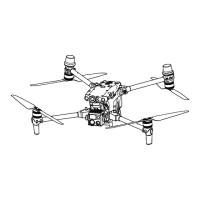23
©
2022 DJI All Rights Reserved.
MATRICE 30 SERIES User Manual
Obstacle Sensing during RTH
The aircraft can sense and avoid obstacles during RTH if the lighting is sucient for obstacle sensing.
The obstacle sensing procedure is as follows:
1. The aircraft decelerates when an obstacle is sensed at approximately 20 m (65.62 ft) ahead.
2. The aircraft stops and hovers, then ascends to avoid the obstacle. Eventually, the aircraft stops
ascending when it is at least 5 m (16.4 ft) above the detected obstacle.
3. The aircraft continues ying to the Home Point at its current altitude.
Approx. 5 meters
Approx. 20 meters
To ensure the aircraft ies forward to the Home Point, the user is unable to rotate the aircraft
during RTH.
During RTH, obstacles on either side of the aircraft cannot be detected or avoided.
Landing Protection
Make sure that the downward vision system is enabled in DJI Pilot 2.
Landing protection is activated during auto landing and is executed as follows:
1. The aircraft will land directly if landing protection determines the ground is suitable for landing.
2. If the ground is determined unsuitable for landing, the aircraft will hover. A prompt will appear in DJI
Pilot 2 pending the next action by the user. The aircraft will start descending only when the battery
level drops to 0%. During this process, the user can still control the orientation of the aircraft.
3. If landing protection is not functioning, DJI Pilot 2 will display a landing prompt when the aircraft
descends below 0.7 m (2.3 ft) above the ground. After making sure the environment is suitable for
landing, tap to conrm or push the throttle stick all the way down and hold for one second, and the
aircraft will land.
Landing protection will not work in the following circumstances:
a. When the downward vision system is disabled
b. When the user is operating the pitch/roll/throttle stick (landing protection will be re-activated
when the control stick is not in use).
c. When the positioning system is not functioning properly (e.g., position drift errors).
d. When the vision system needs calibrating. When the lighting is too dim for the vision system
to operate.
e. If an obstacle is within 1 m (3.28 ft) of the aircraft, no valid observation data is obtained, and
the ground conditions cannot be detected, the aircraft will descend to 0.7 m (2.3 ft) above
the ground and hover pending conrmation by the user to land.

